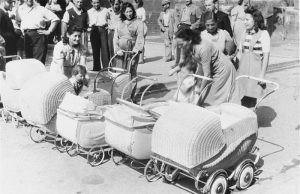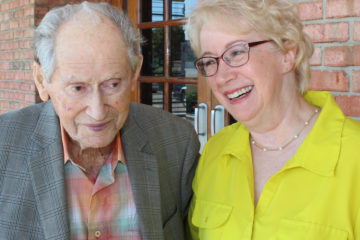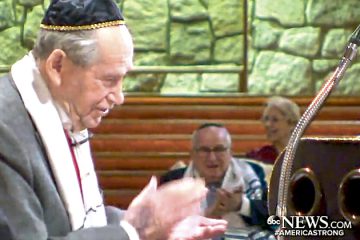THE FIRST ROSH HASHANAH AFTER LIBERATION
By Samuel Heider, Special To The Dayton Jewish Observer
September 2009

My name is Samuel Heider. I was born in Poland in a small village by the name of Biljkow, 70 kilometers from Warsaw. I was the son of very religious Jewish farmers. My father, oleh hashalom, was a gerer rebbe, a chasid, so I was brought up in a very religious home, although it wasn’t easy being a religious Jew with farmland, but if something is dear to you, nothing is impossible.
We had many opportunities to go to America, but my father would argue that American Jews are not observant enough. They drive on Shabbos and they are not kosher. And we remained on the farm until 1941. In 1941 we were forced to leave the farm and sent to a ghetto in nearby shtetl Białobrzegi. And in late September of 1942 the ghetto was liquidated and all the Jews from the ghetto were sent to the gas chambers of Treblinka together with my whole family. One month before the ghetto was liquidated I was sent to several concentration camps including Auschwitz.
After going through a selection in Auschwitz, facing the Angel of Death himself, Josef Mengele, waiting for him to decide if I shall live or I shall die, he finally came to my row and motioned me to the right. Had he motioned me to the left, I wouldn’t be here today, and why he chose me to live I will never know. After surviving Auschwitz I was sent to several more concentration camps, among them was Dachau in which I was liberated April 30, 1945.
After the liberation I weighted only 75 pounds. and I was sent to a erholungs lager stein where I recuperated for 3 months. After my 3 months in lager stein I was sent to a DP camp in Landsberg Am/Lech in August of 1945. It was right after the liberation from the concentration camps I was among the first ones who came to Landsberg Am/Lech.
I came together with perhaps 200 boys from different camps. Some of the boys were from the same little shtetl, Białobrzegi, who survived the same camps that I had been in, and I knew most of them. After we came to Landsberg, almost every day more survivors arrived in Landsberg from different camps. In Landsberg I learned the tragic news that 6 million Jewish people perished in gas chambers and crematoriums of Auschwitz. Majdanek, Treblinka, and others, almost the entire Jewish population in Poland, 3 and one half million Jewish people perished, just a few thousand Jews survived. It was the most difficult and painful time for me. I couldn’t believe it and I kept repeating “6 million Jews perished.” This is almost the entire Jewish population in Europe. I couldn’t cope with the reality.
As for myself, I didn’t know what to do with my life. Several times I was thinking to end my life, but my friends, including my brother-in-law kept telling me, “Look, we also lost our families, but if we all commit suicide there will be nobody left.” They kept telling me, “You have to go on with your life.”

I finally realized that I was not alone and I had to go on with my life. If I committed suicide there wouldn’t be anybody left from my family. After endless sleepless nights, not knowing what to do, talking to myself, I told myself I had to go on for my family. I had to go back to my heritage and to my tradition, and back to my religion in the best way I can. And being before the Yamin Noraim the High Holy Days, I decided to ask some of the boys from the little shtetl Bialobrzegi at Landsberg, it being the first High Holy Days after the liberation. I asked some of the boys what to do as far as the High Holy Days were concerned.
We didn’t have anything for the High Holy Days. No prayer books, no tallesim, no shofar, no Torahs, no place to pray, nothing. But we wanted to celebrate the High Holy Days after the war so we decided to have a meeting to decide what we could do. I said, “We will go to the UNRRA and ask what they can do for us so we can celebrate the first Rosh Hashanah and Yom Kippur after the liberation.”
The UNRRA promised that they would do everything they could to provide us with some prayer books and other necessities that we would need for the High Holy Days services. How would people know about the services? I said, “We will go from door to door and urge them to come to the High Holy Days services, and we will put up signs all over the camp to tell everybody to come to the services.” We had a place that we called Sholem Aleichem Cafe and I told people to come to services there.
I might add that some people I asked to come to the High Holy Days, some of my friends and others argued with me. “Why should I believe in God? Look what God did to us. He let 6 million of his children die in the crematoriums and now you want me to go back and pray on Yom Kippur for forgiveness? Forgiveness for what? I think God should ask us for forgiveness.”
I kept arguing with them, believe me, if God could help, I am sure he wouldn’t let 6 million of his chosen people die. In some cases I succeeded and in some I did not. But in the end I convinced them to come to the High Holy Days services.
We would still need prayer books for the Holy Days, a shofar, Torah, and who would conduct most of the services? As far as shofar and Torah, we didn’t have any of them. We only had about 50 prayer books for the High Holy Days and we only had two weeks before Rosh Hashanah.
A couple of days later, we stayed in camp and kept talking about the approaching High Holy Days. A few of our friends came running and yelling. We saw a lot of Jewish soldiers on trucks and tanks with the Mogen David and the Jewish flags so we all kept running and yelling Yiddishe Zelner, Yiddishe Zelner, Jewish soldiers.
We didn’t have any idea that those soldiers were the Jewish Brigade from Palestine, serving in the British Army. We asked them to come in the camp, but the American M.P.s didn’t allow them to come in. So we talked to them outside the camp for a long time.
Some of them spoke a little Yiddish. Most of them spoke Hebrew. The ones that spoke Yiddish I asked “By any chance do you have a rabbi here?” So one soldier said “Come with me, I will take you to the rabbi.” So I said “I hope the rabbi speaks Yiddish.” We met the rabbi and I said “Rabbi’ and he said “I am not a rabbi. I am a chaplain.” I didn’t know what a chaplain meant, so I called him rabbi.
I said “Rabbi, this is the first time since the liberation from the concentration camps that we will celebrate the High Holy Days, and we don’t have any machzorim (High Holy Day prayer books), nothing for the High Holy Days to pray.”
He said ,“I will give you as much as I can so you can celebrate the High Holy Days.” We were very happy that we would have enough prayer books, tallesim and shofar, but he couldn’t give us the Torah for the High Holy Days. He promised us that he would see to it that we got a Torah. Just before the High Holy Days we were happy to receive the Torah like we had received the Ten Commandments.
But who will read the Torah? I knew somebody who had known how to read the Torah, so I asked my friend Alu Zeidenbaum. He read the Torah at the age of 13. At first he refused. He said he didn’t want to have anything to do with religion anymore. I told him to think about his parents. “They will hear your voice. Do this for your parents and read the Torah in their memory.”

He finally agreed and read the Torah. Finally we had everything that we needed as far as prayer for the High Holy Days was concerned. In that year, the High Holy Days were almost the same time as in 1939. This was the last time I celebrated the High Holy Days with my family. They ran from the end of September through the beginning of October.
The first day of Rosh Hashanah, we didn’t have too many people, but the ones who were there came over to me and kept saying “How do you remember all those melodies? And most of the prayers you did it by heart. All the melodies from Koussevitzky and Yossele Rosenblatt, it’s amazing you went through the most notorious camps; Auschwitz and Dachau and others, and you still remember the beautiful melodies. You conducted the services so beautifully.” The news spread quickly all over the camp about my services.
The second day, Rosh Hashanah there weren’t enough seats. Everybody came and they all said “We came to hear your beautiful melodies.” On Kol Nidre night, we had to move to a bigger place and everybody was singing with me Kol Nidre and on Yom Kippur it was the same. The whole camp came, men, women, and a few children.
I conducted the Yom Kippur services and I made El Moley Rachamim for the first time after the liberation. I named 6 of the most notorious concentration camps in memory of the 6 million Jewish people who perished in those camps: Auschwitz, Majdanek, Treblinka, Buchenwald, Bergen-Belsen, and Dachau. Every time I named a camp, the crying became louder and louder until the crying was louder than the prayers.
I can not describe the joy, the crying, the kisses. They all expressed their gratitude that I had convinced them to go back to our heritage, our tradition, most of all, to our religion as Jews. As for myself, I fulfilled my commitment and by doing so, I honored my family by conducting the High Holy Days services in their memory. They heard my voice, and they will sleep in peace.



